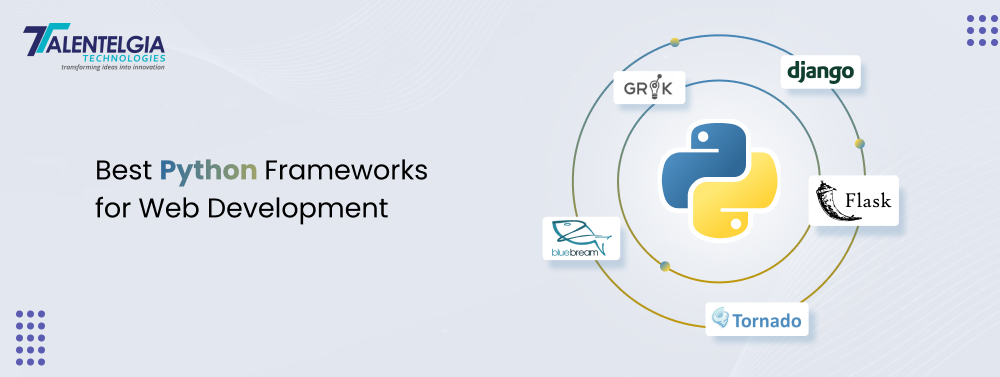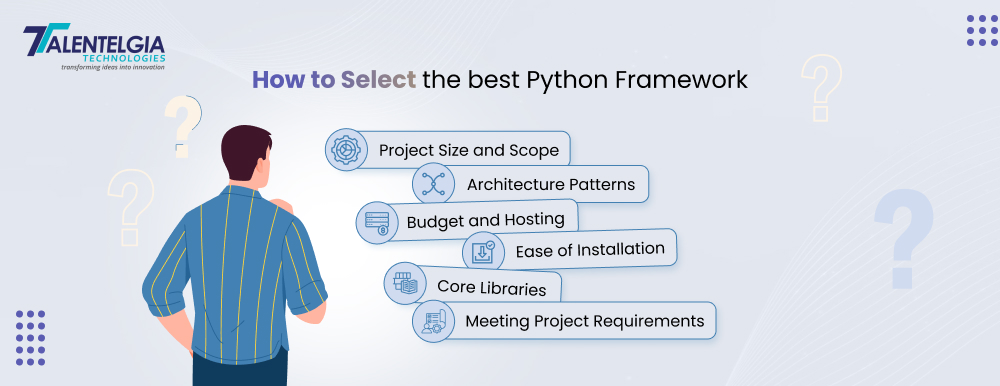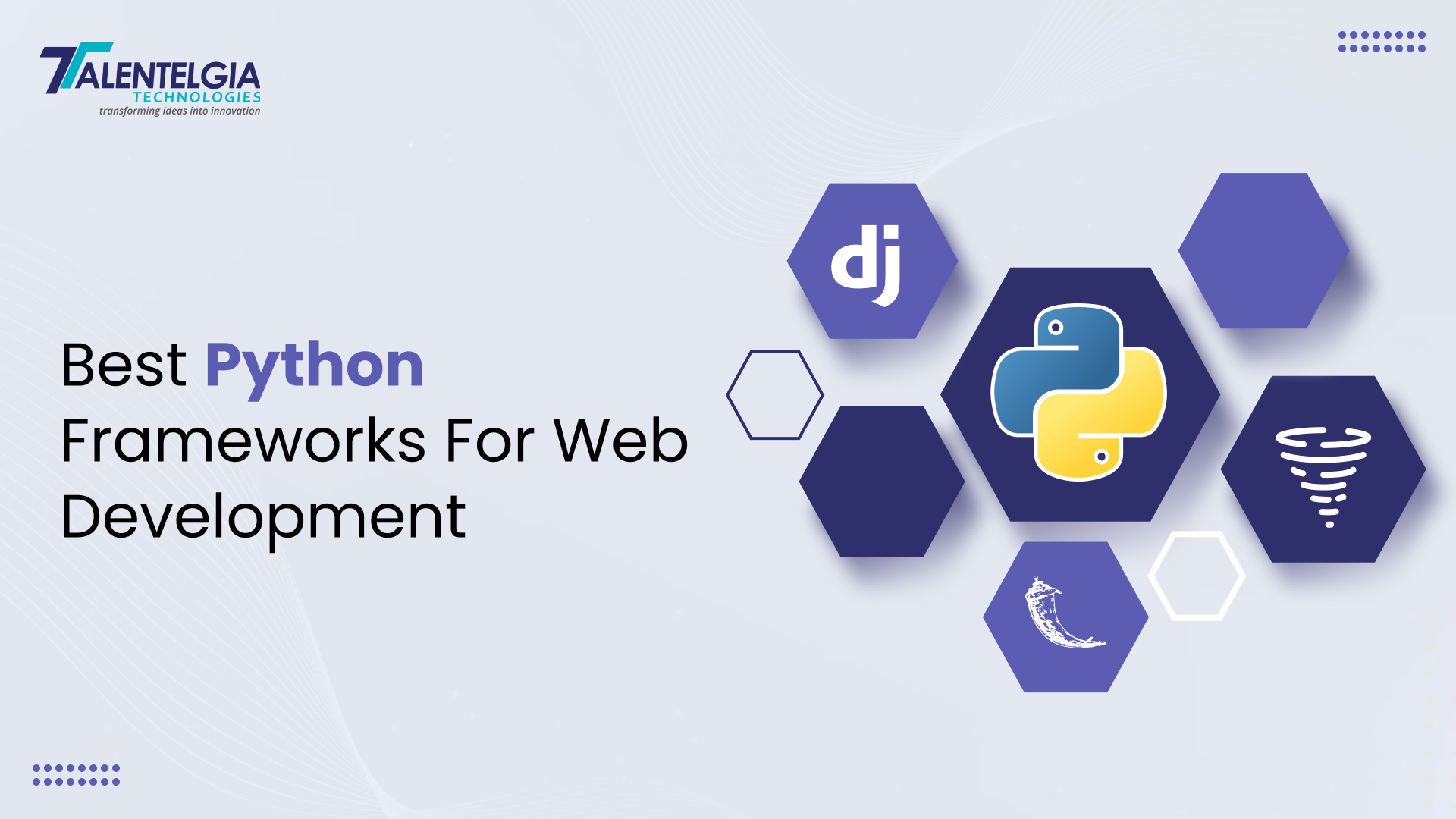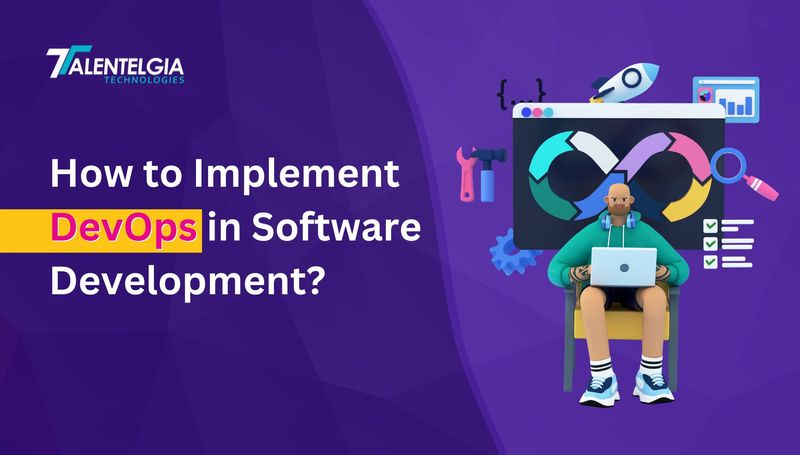Python has become one of the popular programming languages for web development. This is mainly because of its simplicity, versatility, and rich ecosystem of libraries. The language has an easy-to-learn syntax. Moreover, developers often have multiple options when selecting the best Python frameworks for web development.
Now, the question arises, which is the best Python framework for web development? Well, each framework has its strengths. You have to choose the right framework depending on your business requirements. Factors like project complexity and the need for increased efficiency will determine the right framework for you. Sounds vague right? Well, in this blog we will uncover the different kinds of Python frameworks and the best Python frameworks for web development. We will also help you choose the right framework for your business requirements. Let’s dive right in!
Types of Python Frameworks for Web App Development
Python Frameworks are categorized based on their functionality and purpose. Each framework serves a different need. For instance, you might need a different framework for building a web application from scratch and a completely different one for specialized tasks. Here are the three main types of Python frameworks:
- Full Stack Framework
A full-stack framework or enterprise framework has built-in libraries that offer a comprehensive solution for various tasks. This includes creating forms, templates, and layouts. Full stack handles backend, front end, and database functionalities. A few examples would be Django, Pyramid, Cubic Web, and Turbo Gears.
- Micro Frameworks
Micro Frameworks are lightweight Python frameworks for web app development. They usually have limited features and functionalities and are ideal for specific tasks. Moreover, they are ideal for small to medium-sized projects where simplicity and minimal overhead are crucial. Some examples would be Flask, Dash, and Pycnic.
- Asynchronous Frameworks
Asynchronous frameworks are designed to manage large numbers of concurrent connections. They leverage Python’s Asyncio library to handle tasks asynchronously.
These frameworks support non-blocking I/O operations. With this feature, a single thread can handle thousands of connections very efficiently. Hence, they are mainly used for real-time applications, WebSockets, chat applications, and long-polling systems, which require managing lots of users simultaneously. Some examples include Tornado, Sanic, and Growler.
Now let’s uncover the best Python Frameworks for Web Development.
Best 5 Python Frameworks For Web Development

1. Django
Django is a free, open-source Python framework that enables the rapid development of complex applications. It allows developers to create high-quality web apps seamlessly. Its ecosystem supports everything from user authentication to data management. This makes it a great choice for data-driven applications. Moreover, it is used by major platforms like Instagram and Pinterest which underscores its reliability.
If we are talking about numbers, over 12000 projects have been created in it which further asserts its usefulness. A major factor that contributes to its popularity is its extensive library and coding reusability.
Let’s take a closer look at its pros and cons.
Pros:
- Easily define URL patterns using a powerful URL dispatcher
- Integrated authentication system for secure user management
- DRY (Don’t repeat yourself) principle for enhanced code reusability
- Active community support
Cons:
- Not suitable for smaller projects due to its comprehensive nature
- Less flexibility
- Need extensive familiarity with the structure for optimal usage.
- Can face performance issues if handling a large volume of requests.
Want more information about Django? Click Here!
2. Flask
Flask is an easy-to-use microweb framework. It enables developers to build web applications seamlessly while maintaining scalability. Flask’s minimalist design makes it an appealing choice for developers who prefer a lightweight framework without any unnecessary add-ons. Moreover, it is very extensible, allowing the integration of third-party libraries for improved functionality. This makes it suitable for small to medium-sized projects, RESTful APIs, and prototypes.
Let’s understand it better by looking at the pros and cons.
Pros:
- Modular design enables developers to choose the libraries they need.
- Lightweight framework
- RESTful request handling
- Built-in development server.
Cons:
- Not very suitable for large projects owing to its simple framework.
- No built-in form validation
- No built-in support for user authentication
- Handles only minimum eros by default.
3. Tornado
Tornado is one of the best Python frameworks for web app development. It is well suited to build scalable applications that require robust network connections like web sockets and HTTP/2 connections. Moreover, its asynchronous architecture enables it to manage thousands of connections with minimal resources. This makes it ideal for scalable, low-latency applications like streaming and live chat.
Tornado also provides a simple web framework with routing and request handlers but leaves much of the application structure to the developer. It is important to note that while Tornado is great in real-time communication, it does have a steep learning curve.
Pros:
- Tornado can handle thousands of simultaneous connections with minimum resource usage.
- Built-in Support for web sockets and web polling
- Offers a minimalist Python framework for web app development
- Can handle multiple I/O bound tasks like database queries
Cons:
- Does not offer out-of-box features
- Uses a single thread to manage all tasks. This means that it can slow down if too many requests are handled at once.
- Does not have a large community support.
- It’s not ideal for a simple application.
4. Blue Beam
BlueBream is an open-source framework, server, and library for online application development. Formerly, it was called Zope 3, and it was created by the Zope team. The framework suits medium to large-sized operations divided into reusable, flexible components.
BlueBream is dependent on Zope Toolkit, which has ample experience, guaranteeing durability, consistency, and adaptability in coding. Thus, it can be ensured that BlueBream meets the key requirements for durable, consistent, and adaptable code. The framework is designed to foster separation of concerns, helping in organizing code and maintaining flexibility as applications grow. It supports robust creation of secure, efficient, and extensible web applications.
Pros:
- It is focused on Python WSGI compatibility.
- It offers frameworks for unit and functional testing.
- It follows security best practices.
- It uses XHTML-compliant language to develop templates
Cons:
- BlueBream is difficult to learn for new Python or Zope framework developers.
- It’s not suitable for simple applications.
- Its component-based architecture and a high number of features may overwhelm developers.
- BlueBream has fewer developers and resources as compared to other popular frameworks such as Django or Flask.
5. Grok
Grok is another popular Python framework for web app development. It is built on the Zope Toolkit technologies. The framework focuses on agile development based on two principles including convention over configuration and Do not repeat yourself (DRY). Grok is an open-source framework that helps speed up application development and allows developers flexibility to choose any libraries based on their requirements. The UI of Grok is very much like the other full-stack Python frameworks such as Pylons and TurboGears.
Pros:
- Creates a solid basis for developing sophisticated, flexible web applications.
- Makes use of Zope 3’s features for more functionality.
- Has a strong object storage database.
Cons:
- Grok has its templating system, which may not allow for much flexibility for developers who are used to or prefer the more popular template engines like Jinja2.
- While Grok leverages the power of the Zope framework, it can feel very tightly coupled to Zope, which may not be appealing to developers who want to have more freedom or flexibility in choosing components from other ecosystems.
How to Select the Best Python Framework
Selection of the best Python framework for web development depends on several factors that influence the project’s success. The framework selected should align with your project’s size, complexity, scalability needs, and budget. Moreover, it should also ensure ease of use and future maintainability.

Project Size and Scope
Start by assessing your project’s size and requirements. Full-stack frameworks like Django or Pyramid are ideal for large-scale applications with complex features, while micro frameworks like Flask or Bottle suit smaller projects with minimal needs.
Architecture Patterns
Most frameworks adopt architecture patterns like MVC (Model-View-Controller), MVP (Model-View-Presenter), MVA (Model-View-Adapter), or MVVM (Model-View-ViewModel). The above patterns keep data handling, UI, and logic separate and result in code that is much more maintainable and structured. Choose a pattern that best fits your project’s structure and complexity.
Budget and Hosting
Budget constraints also play a role in framework selection. Dedicated hosting guarantees performance, but it may be expensive. Shared hosting, though economical, lacks advanced modules that may be required for applications.
Ease of Installation
Frameworks that are easy to install and deploy, like Flask and Web.py, ease the development process and make it easier to get over deployment problems. Choose frameworks that have the least amount of setup and deploy without hassle in production.
Choose frameworks with rich resources and a minor learning curve. Flask and FastAPI offer great tutorials that are suitable for freshers. Django is documentation-intensive and suited more to experienced developers.
Core Libraries
Save unnecessary time by not rewriting the same code repeatedly. This can be assured if you choose a framework that has a powerful core library. Consider frameworks with basic features offered, such as templating, authentication, caching, and validation of data.
Meeting Project Requirements
The best Python framework for web development depends on your project needs. For flexibility and lightweight applications, Flask is the best. For full-fledged, scalable applications, Django is the best.
Conclusion
Choosing the best Python frameworks for web development is more than just a technical decision. It shapes the foundation of your project’s success. Whether you’re crafting a lightweight app with Flask or building a robust enterprise solution with Django, aligning the framework with your project’s scale, complexity, and goals is key. The beauty of Python lies in its versatility, offering frameworks for every need, from micro to full-stack and asynchronous solutions.
Take time to assess the specific needs of your project, and consider the scope each framework may offer. You can invest in the one that meets today's needs and tomorrow's ambitions without a hitch. With the right tools, your developmental journey can be smoother, faster, and more rewarding.


 Healthcare App Development Services
Healthcare App Development Services
 Real Estate Web Development Services
Real Estate Web Development Services
 E-Commerce App Development Services
E-Commerce App Development Services E-Commerce Web Development Services
E-Commerce Web Development Services Blockchain E-commerce Development Company
Blockchain E-commerce Development Company
 Fintech App Development Services
Fintech App Development Services Fintech Web Development
Fintech Web Development Blockchain Fintech Development Company
Blockchain Fintech Development Company
 E-Learning App Development Services
E-Learning App Development Services
 Restaurant App Development Company
Restaurant App Development Company
 Mobile Game Development Company
Mobile Game Development Company
 Travel App Development Company
Travel App Development Company
 Automotive Web Design
Automotive Web Design
 AI Traffic Management System
AI Traffic Management System
 AI Inventory Management Software
AI Inventory Management Software
 AI Software Development
AI Software Development  AI Development Company
AI Development Company  AI App Development Services
AI App Development Services  ChatGPT integration services
ChatGPT integration services  AI Integration Services
AI Integration Services  Generative AI Development Services
Generative AI Development Services  Natural Language Processing Company
Natural Language Processing Company Machine Learning Development
Machine Learning Development  Machine learning consulting services
Machine learning consulting services  Blockchain Development
Blockchain Development  Blockchain Software Development
Blockchain Software Development  Smart Contract Development Company
Smart Contract Development Company  NFT Marketplace Development Services
NFT Marketplace Development Services  Asset Tokenization Company
Asset Tokenization Company DeFi Wallet Development Company
DeFi Wallet Development Company Mobile App Development
Mobile App Development  IOS App Development
IOS App Development  Android App Development
Android App Development  Cross-Platform App Development
Cross-Platform App Development  Augmented Reality (AR) App Development
Augmented Reality (AR) App Development  Virtual Reality (VR) App Development
Virtual Reality (VR) App Development  Web App Development
Web App Development  SaaS App Development
SaaS App Development Flutter
Flutter  React Native
React Native  Swift (IOS)
Swift (IOS)  Kotlin (Android)
Kotlin (Android)  Mean Stack Development
Mean Stack Development  AngularJS Development
AngularJS Development  MongoDB Development
MongoDB Development  Nodejs Development
Nodejs Development  Database Development
Database Development Ruby on Rails Development
Ruby on Rails Development Expressjs Development
Expressjs Development  Full Stack Development
Full Stack Development  Web Development Services
Web Development Services  Laravel Development
Laravel Development  LAMP Development
LAMP Development  Custom PHP Development
Custom PHP Development  .Net Development
.Net Development  User Experience Design Services
User Experience Design Services  User Interface Design Services
User Interface Design Services  Automated Testing
Automated Testing  Manual Testing
Manual Testing  Digital Marketing Services
Digital Marketing Services 
 Ride-Sharing And Taxi Services
Ride-Sharing And Taxi Services Food Delivery Services
Food Delivery Services Grocery Delivery Services
Grocery Delivery Services Transportation And Logistics
Transportation And Logistics Car Wash App
Car Wash App Home Services App
Home Services App ERP Development Services
ERP Development Services CMS Development Services
CMS Development Services LMS Development
LMS Development CRM Development
CRM Development DevOps Development Services
DevOps Development Services AI Business Solutions
AI Business Solutions AI Cloud Solutions
AI Cloud Solutions AI Chatbot Development
AI Chatbot Development API Development
API Development Blockchain Product Development
Blockchain Product Development Cryptocurrency Wallet Development
Cryptocurrency Wallet Development About Talentelgia
About Talentelgia  Our Team
Our Team  Our Culture
Our Culture 
 Healthcare App Development Services
Healthcare App Development Services Real Estate Web Development Services
Real Estate Web Development Services E-Commerce App Development Services
E-Commerce App Development Services E-Commerce Web Development Services
E-Commerce Web Development Services Blockchain E-commerce
Development Company
Blockchain E-commerce
Development Company Fintech App Development Services
Fintech App Development Services Finance Web Development
Finance Web Development Blockchain Fintech
Development Company
Blockchain Fintech
Development Company E-Learning App Development Services
E-Learning App Development Services Restaurant App Development Company
Restaurant App Development Company Mobile Game Development Company
Mobile Game Development Company Travel App Development Company
Travel App Development Company Automotive Web Design
Automotive Web Design AI Traffic Management System
AI Traffic Management System AI Inventory Management Software
AI Inventory Management Software AI Software Development
AI Software Development AI Development Company
AI Development Company ChatGPT integration services
ChatGPT integration services AI Integration Services
AI Integration Services Machine Learning Development
Machine Learning Development Machine learning consulting services
Machine learning consulting services Blockchain Development
Blockchain Development Blockchain Software Development
Blockchain Software Development Smart contract development company
Smart contract development company NFT marketplace development services
NFT marketplace development services IOS App Development
IOS App Development Android App Development
Android App Development Cross-Platform App Development
Cross-Platform App Development Augmented Reality (AR) App
Development
Augmented Reality (AR) App
Development Virtual Reality (VR) App Development
Virtual Reality (VR) App Development Web App Development
Web App Development Flutter
Flutter React
Native
React
Native Swift
(IOS)
Swift
(IOS) Kotlin (Android)
Kotlin (Android) MEAN Stack Development
MEAN Stack Development AngularJS Development
AngularJS Development MongoDB Development
MongoDB Development Nodejs Development
Nodejs Development Database development services
Database development services Ruby on Rails Development services
Ruby on Rails Development services Expressjs Development
Expressjs Development Full Stack Development
Full Stack Development Web Development Services
Web Development Services Laravel Development
Laravel Development LAMP
Development
LAMP
Development Custom PHP Development
Custom PHP Development User Experience Design Services
User Experience Design Services User Interface Design Services
User Interface Design Services Automated Testing
Automated Testing Manual
Testing
Manual
Testing About Talentelgia
About Talentelgia Our Team
Our Team Our Culture
Our Culture

















 Write us on:
Write us on:  Business queries:
Business queries:  HR:
HR: 




